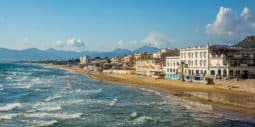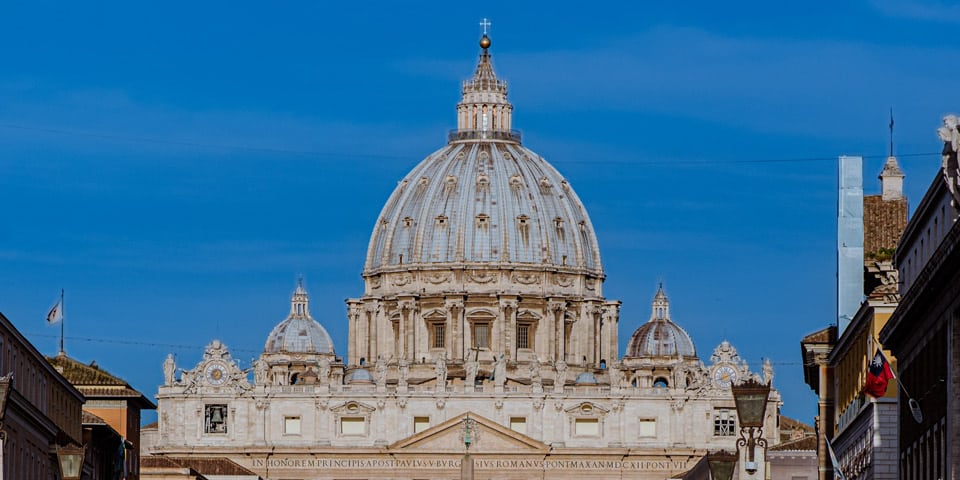

23573 travellers read

| Tickets |
|
|---|---|
| Tip | Take a bottle of water with you. Large bags or purses are not allowed in the Basilica. There is a drop-off point for all bags in a room to the right of the church steps. |
| Opening hours |
Monday:
-
Tuesday:
-
Wednesday:
-
Thursday:
-
Friday:
-
Saturday:
-
|
| Recommended tour | |
| Closest bus stops |
|
| Closest subway stations |
|
| Address | Piazza San Pietro, Città del Vaticano |
| Website | www.basilicasanpietro.va |
Climbing to the top of the cupola (dome) of St Peter’s Basilica is a must-do experience during your Roman holiday. The dome offers the highest viewpoint in Rome and is located within the Vatican. From its observation deck, you can enjoy breathtaking panoramic views of the city. To make the most of your visit, it’s advisable to arrive in the morning to enjoy the scenery without the crowds and to avoid long queues.
Contents
ToggleThe dome opens at 07:30, and you must pass through a security check before beginning your ascent. After clearing security, look to your right for signage directing you to the ticket kiosk for the dome. Please note that payment is accepted in cash only.
As you head towards the ticket desk, you’ll pass the entrance to the basilica on the right side of the colonnade, followed by the Holy Door. Turn left to find the kiosk where tickets are sold. After a short 30-second lift ride, there is an opportunity to stop for a coffee or use the facilities at the dome level.
The climb to the top involves increasingly narrow and sloped stairways, which may be uncomfortable for those who suffer from claustrophobia.
It can also become quite crowded and hot, particularly during the summer. Thankfully, small windows along the way provide ventilation and spots to pause and rest.
Despite the physical effort involved, the climb is truly rewarding, offering magnificent views over Rome and the Vatican.
At the summit, you even have the chance to send a postcard from the highest point in Vatican City. Postcards start from €0.50, with stamps priced at €2.30 for the United States and €1.00 for Europe.
The souvenir shop also offers themed postcards featuring the Vatican Museums, the Sistine Chapel, Popes, and the Swiss Guard.
The Great Dome rises above the altar, with the Baldacchino beneath, richly adorned with mosaic and stucco decorations. It is supported by four colossal structural piers, each with a perimeter of 71 metres and a height of 120 metres from ground level to the roof. Inscribed within the dome are two Latin phrases: “Hinc una fides mundo refulget” (From here, a single faith shines throughout the world) and “Hinc sacerdotii unitas exoritur” (From here, the unity of the priesthood arises).
The dome is divided into sixteen ribs and sections, each richly decorated with impressive imagery, including:
In total, 96 figures are set against a deep blue sky adorned with stars.
Above these, the lantern bears the Latin inscription: “Ad maiorem Petri gloriam Sixtus V Pontifex Maximus anno MDCXC pontificatus sui quinto” (To the glory of St Peter, Pope Sixtus V in the year 1590, the fifth of his pontificate). Following Michelangelo’s death, many artists contributed to the decoration of the dome. Pope Clement VIII later commissioned Giuseppe Cesari (Cavalier d’Arpino) to complete the upper part.
For a truly memorable experience, consider joining a private tour of the Vatican at sunrise, which includes a climb to the dome.
Michelangelo Buonarroti designed the dome of St Peter’s Basilica, drawing inspiration from the domes of Florence Cathedral and the Pantheon, designed by Brunelleschi. Michelangelo envisioned a structure that fused classical harmony with pioneering engineering. When he passed away in 1564, the basilica still lacked its chapels, façade, and dome—only the columns and the drum had been completed.
In 1587, Giacomo della Porta, assisted by Domenico Fontana, assumed responsibility for the project. They were tasked with bringing Michelangelo’s vision to life while working with the structural limitations of the existing drum. Their alterations included a steeper dome curvature and an extended lantern to enhance verticality. Within just two years, the dome was completed—a remarkable feat and a lasting symbol of Renaissance brilliance. According to legend, Michelangelo made his dome 1.5 metres (5 feet) shorter than the Pantheon, declaring, “I could build one bigger, but not more beautiful, than that of the Pantheon.”
The dome rises 133.3 metres above ground level, with an internal height of 117.57 metres and an inner diameter of 41.5 metres. Weighing 14,000 tonnes, it features a double-shell design that combines durability with elegance. The inner shell is built of lightweight tufa, while the outer shell consists of heavier travertine—an ingenious pairing that maintains strength while minimising stress on the base.
The dome was designed to symbolise the heavens, representing divine perfection through ideal proportions. While Michelangelo originally envisioned a hemispherical dome akin to the Pantheon, the final version was slightly pointed to minimise lateral thrust. The use of double-ribbed construction was a breakthrough, effectively distributing weight and permitting the installation of large windows at the dome’s base, allowing natural light to flood the space below. These features make the dome of St Peter’s Basilica a masterpiece of Renaissance architecture.
The following table highlights some of the world’s most significant domed structures, ranked by their maximum internal height in metres. St Peter’s Basilica tops the list, showcasing its architectural prominence among global landmarks.
| # | Name of the Structure | Inner Height | Outer Height | Date of Construction | Diameter | City, Country |
|---|---|---|---|---|---|---|
| 1 | St. Peter's Basilica | 118 | 137 | 1506–1590 | 43 | Vatican City |
| 2 | Florence Cathedral | 115 | 117 | 1420–1436 | 38 | Florence, Italy |
| 3 | Basilica of Our Lady of Peace | 111 | 158 | 1985–1989 | 90 | Yamoussoukro, Ivory Coast |
| 4 | People's Salvation Cathedral | 106 | 135 | 2010–present | 29 | Bucharest, Romania |
| 5 | Rotunda of Mosta | 96 | 96 | 1833–1860 | 37 | Most, Malta |
| 6 | AT&T Stadium | 91 | 2005–2009 | Arlington, Texas, USA | ||
| 7 | Berlin Cathedral | 85 | 98 | 1894–1905 | 33 | Berlin, Germany |
| 8 | St. Paul's Cathedral | 65 | 111 | 1675–1710 | 31 | London, United Kingdom |
| 9 | Hagia Sophia | 56 | 56 | 532–537 | 31 | Istanbul, Turkey |
| 10 | United States Capitol | 55 | 88 | 1793–1866 | 29 | Washington, D.C., USA |
| 11 | Sultan Ahmed Mosque | 43 | 43 | 1609–1616 | 22 | Istanbul, Turkey |
| 12 | Florence Baptistery | 41 | 41 | 1059–1128 | 26 | Florence, Italy |
| 13 | Santa Maria di Loreto | 32 | 32 | 1507–1512 | 22 | Rome, Italy |
Author: Kate Zusmann
This website uses cookies. For more info read the cookies policy
RomeItaly.guide © 2025. Created with love by Roman experts and guides.